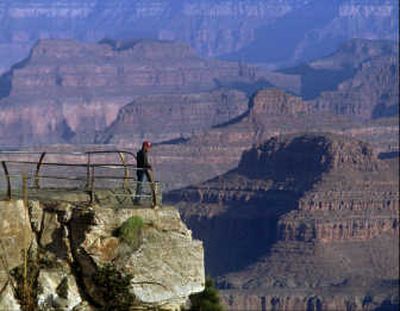Our travel tradition urges energy answers

Not long after gas hit $4 a gallon in Spokane, I flew to California to join my daughter for a trip we’d been anticipating for weeks. She drove me past a Chevron station in Santa Barbara and laughed at my naiveté. Unleaded was selling there for $4.77 a gallon.
Then we loaded up her car for a most unlikely vacation this summer, a 2,000-mile road trip that would take us to two of the country’s iconic national parks, the Grand Canyon and Mount Rushmore, and housefuls of extended family along the way. We had only one weapon for fighting high gas prices: her brand new, bright red Honda Fit, a subcompact with both the sticker price and the gas mileage to match a graduate student’s budget.
This car, embraced by Europeans as the Honda Jazz, only became available in the U.S. in 2007. It was ranked by the American Council for an Energy-Efficient Economy as one of the “greenest cars of 2008.” And sure enough, as we soared across the contemporary path of old Route 66 through California and into Arizona, the Fit managed to hit 38 miles to the gallon.
As we left the Mojave Desert and headed toward Mr. D’z Route 66 Diner in Kingman, Ariz., prices began to decline to $4.39 a gallon.
Fifty years ago, American families piled into station wagons for similar trips along Route 66, fueled by gasoline costing around 20 cents a gallon and a desire to visit the national parks of the West. They crowded into neon-lit motels and diners along the highway.
The afternoon we walked into Mr. D’z pink and turquoise dining room, Elvis Presley was singing “Are You Lonesome Tonight?” on the jukebox. That diner certainly was. The place was nearly empty as we ordered french fries and homemade root beer.
The next day, our guidebook warned of 20- to 30-minute waits at the Grand Canyon’s popular South Rim entrance. But as we zipped through a short line to buy our entrance pass, a park employee told us attendance was down 30 percent from a year ago.
It’s likely that employee was exaggerating. National Park Service officials in Washington, D.C., and the Grand Canyon told me last week that it was still too early in the summer to make any firm conclusions about the effect of high gas prices on park visitation. Recreational visits to the Grand Canyon were down only 2.8 percent for the month of May.
But tourism chief Dean Reeder wrote in an e-mail that never before have we seen gasoline prices jump so quickly or so high. American families are facing higher costs this summer for nearly every commodity they buy and an onslaught of news about the weakening economy. For those reasons, he predicts they’ll hold back on travel this summer. “Put me down” he wrote, “as cautiously pessimistic.”
Our journey also took us to the Museum of Indian Arts & Culture in Santa Fe, N.M. At the end of the exhibit, we paused by a plaque bearing the words of a Navajo professor, Luci Tapahonso: “We must remember the worlds our ancestors traveled,” she wrote. “Always wear the songs they gave us. Remember we are made of prayers. Now we leave wrapped in blankets of love and wisdom.”
Tapahonso’s words reminded me that humans have always needed to make similar journeys. We planned to culminate ours last week with family gatherings and fireworks at Mount Rushmore.
My children and grandchildren will want to travel these worlds as well. The U.S. must work quickly to develop alternative fuels and innovative designs that can keep American families on the road in the years to come.
One day, I hope my daughter and I look back at the gas mileage we tallied during the summer of 2008 and laugh. Then we can rank her bright red Honda Fit with the Ford station wagons of my childhood – as just another gas-guzzler from the past.